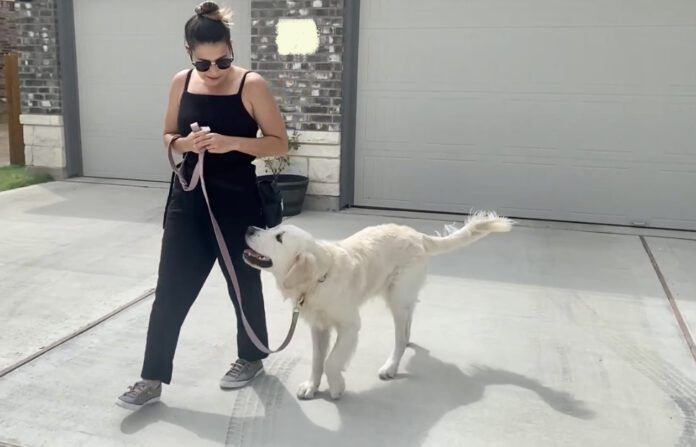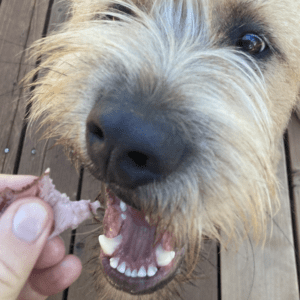
Almost 20 years into my dog training career, “Leave it” is probably one of the cues that I say the least – and yet, how to train a dog to “leave it” is one of the most-wanted behaviors that people wish their dogs could learn. Why do I not teach the use of a “leave it” cue? Because by the time you can even verbalize the word “Leave,” your dog has likely already made the decision to go for whatever “it” is; the cue is often too delayed. Moreover, the “leave it” cue is often over-used and under-rewarded.
Over-use of a cue leads to learned irrelevance – which means that the cue means nothing to the dog – or an unreliable behavior, with the dog deciding each time he’s been cued whether it’s more rewarding to just go for “it” than to “leave it.” I often see people repeating “Leave it! Leave it! Leave it!” – and when the dog does leave it, I rarely see the dog rewarded for his effort.
But “leave it” is absolutely a valuable skill for dogs to have in their behavioral repertoire. Instead of teaching it with a verbal cue, though, I teach it by using the sight of the stimulus (the trigger, object of interest, or thing that you want the dog to “leave”) as the dog’s cue to disengage with the thing and check back in with you.
For example, to teach a dog to not chase a bird, I use the sight of a bird as the cue to check back in with me. In my experience, teaching “leave it” this way is more successful than with a verbally cued “leave it.”
Identify the goal or end-game behavior you want
As with all training, the first step is to be clear about the behavior you want your dog to display in a given situation – the “end game” or target behavior. For example, when my dog sees a bird, I want him to disengage from the bird – to refrain from chasing it – and make eye contact with me. My goal is to build and reinforce a “check in with me” behavior that will replace his natural response of fixating and chasing birds that he sees. However, I want my dog to offer the check-in behavior without any cues from me; in this case, ultimately, the cue will be the sight of a bird.
Eye Spy: Teaching your dog to check in with you
To teach this, I start by playing a game called “Eye Spy.” To play, start indoors, with your dog in front of you. Place a small (pea-sized) treat halfway between you and your dog and centered between your feet and their paws. Allow your dog to eat the treat and wait, watching your dog. Almost always, your dog will look at you for more information: “Are there more treats?”
The moment your dog makes eye contact with you, mark it with a clicker or the marker of your choice (such as the word “Yes!”) and then place another treat in the same spot as before. You want the treat between the two of you, so that it’s easy for your dog to take the treat and then look up at you. This prompts a pattern: Your dog looks down (at the treat) and then up (at you), down, up, etc., on repeat.
Keep marking (click or “Yes!”) and putting treats down and repeat about 10 times. Now try the exercise in three new locations.
Teach the first step of “Engage-Disengage” (Engage)

Next, teach your dog to “engage” as the first part of the classic “Engage-Disengage” game (also known as “Look at That”). I prefer to use a novel stimulus to initially teach this, but you can use anything your dog is unfamiliar with. This could be a kid’s toy, a remote-controlled car, or even food on a paper plate. In this game, to “engage” means to look calmly at a novel stimulus.
With your dog on a leash in front of you, place (or have a helper place) the novel stimulus perpendicular to where you are, so that your dog must swivel his head 90 degrees to look at it. You can do a “temperature check” at this point (see sidebar below) or you can wait for your dog to look at the novel stimulus. Either way, mark the moment that your dog looks at the stimulus (click or “Yes!”), and then feed your dog a treat in the opposite direction – ideally by tossing the reward away. By tossing the treat away from the stimulus, you start to add “movement away from the stimulus” as part of the target behavior.
At this juncture, use a 1:1 ratio of reward to behavior for each time your dog looks at the stimulus; this means your dog will receive one reward every time he looks at the stimulus. As with the Eye Spy game, mark each behavior (looking at the stimulus) and feed for position (give him a treat in the opposite direction as the stimulus). Repeat for a minimum of two sets of 10 to 15 repetitions.
The second phase of Engage-Disengage (Disengage)

When your dog can engage with a novel stimulus consistently and reliably, start withholding the marker for two to three seconds. When your dog looks at the stimulus, wait two to three seconds before doing anything. If your dog checks in with you (looks at you), reward him for disengaging with the novel stimuli – but now, rather than rewarding him on a 1:1 ratio (one behavior = one treat), use an average ratio of 1:5 (one behavior = an average of 5 treats, fed consecutively, one after another).
How do you give your dog an “average” number of treats? If you give him three treats consecutively this time and seven the next time, it averages out to about five treats per behavior. You want the behavior of disengaging with the stimuli and checking in with you to be, on average, five times more reinforcing than it is to look at the novel stimulus.
If your dog does not check back in with you, take a few steps away from the stimulus and try again, starting with the 1:1 behavior:treat ratio. The same process will apply when you take this outdoors into the real world. If you are too close to the tempting or distracting stimulus, it will be more difficult for your dog to take his eyes off of it and look at you instead. Distance is what I refer to as the “X factor” – it can make or break the outcome of a situation.
Taking Engage-Disengage into the real world
When your dog is ready to take this exercise to the next step, identify which stimulus you plan to address. Is it birds, squirrels, dogs, or something else that grab his attention? Scout out a location where this stimulus will be present – but be sure to choose an “easy” environment – where you can get far enough away from the stimulus to move freely. This should be a familiar location for your dog with few other distractions or triggers.
Any time you venture to a new location, do some temperature checks (see sidebar, “Take Your Dog’s Emotional Temperature”). Can your dog offer behaviors that are reliable, is he able to play the Eye Spy game, will he take a treat from you – and if he will take food, does he take it in the same manner with which he normally takes food?
This is key to making the most of the learning opportunity. If your dog is too stimulated or triggered, it’s unlikely that any quality learning will occur. Do not skip the temperature checks. These are a crucial to ensuring that your dog is primed to learn.
Be aware that just because your dog knows this game at home, there is no guarantee that he will be immediately successful elsewhere. Adjust your criteria; start by expecting less and rewarding more. Return to the first phase of Engage-Disengage by just marking and rewarding your dog as soon as he registers the stimulus.
If your dog repeatedly turns to look at the stimulus right after taking a treat, just keep marking and rewarding these engagements and continue the process. It is totally normal for a dog to glance at real world stimuli multiple times in a row. Remember that each look starts a new repetition. The number of glances per stimulus will reduce as you continue the process and is also how you will know he is ready to transition to the disengage part of the exercise – where he’ll earn an average of five consecutive rewards for looking away from the object and at his handler instead.
Many people get discouraged when their dog won’t disengage from the triggering stimuli and check in with them. I encourage them to just keep repeating the “engage” part of the exercise – and to notice that their dog is no longer lunging, pulling, vocalizing, fixating, freezing, avoiding, or speeding up when they see the object of interest.
This process is fluid. On some days, your dog may be perfectly able to consistently disengage from the birds, squirrels, other dogs, etc. On other days, your dog may be prone to reacting or require more distance to be successful. This is totally normal. Here are some general guidelines to help you decide when you should revert to marking and rewarding for just the engage, even if you were previously able to work on the disengage phase. Go back to working on just the engage phase if:
- It is taking more than 2 or 2.5 seconds for your dog to disengage, and/or
- Your dog is displaying the initial signs of a reactive display, and/or,
- You cannot guarantee that your dog will check back in, and/or
- Your dog rehearsed the behavior you are trying to modify (i.e., chasing or obsessing about a bird) before he was able to disengage.
Progress is perfect
There are many factors that may affect your dog’s reaction: the speed or intensity of the stimulus; your dog’s distance from the stimulus; trigger stacking (stress on top of stress on top of stress for your dog); fatigue; weather; the dog’s baseline that day; the direction that the stimulus moved; the value of your rewards that day; the dog’s reinforcement history; the dog’s overall mental and emotional state; and more!
But throughout this process, you will start to notice that your dog is increasingly capable of disengaging when he sees the stimulus. So rather than barking, lunging, chasing, etc., he can now simply look at the stimulus, disengage from it, and check back in with you. Hurrah! The trend is improving.
Remember that practice makes progress; consistency, patience, grace, and time are essential to any process. The learning process is not linear. There will be great days and then there will be other days that crush your soul but remember that on those hard days, your dog is having a tough time. View those situations as neither good nor bad but simply experimental data – more like a science experiment and less than a reflection of you!
Last, be sure to celebrate the small wins and have fun along the way. Make time to engage in activities that your dog enjoys and to find mutually enjoyable activities to keep both of your emotional cups full. Finding joy in the journey is one of my favorite parts of living and working with animals. It is so much less about the destination and so much more about what we learn along the way.
Whenever you go to a new location, do a “temperature check” with your dog to see how he’s likely to handle being with you in the new environment. This will give you information about any adjustments you might need to make in order for him to succeed before you head down a trail together.

Is he “running hot” – so overwhelmed or overexcited that he can barely acknowledge you? If so, the likelihood of your success handling him in that environment is low; it may be wise to reschedule your walk. Or is he just nicely “warmed up” – excited but still able to check in with and respond to you? If so, you can start down the trail, but keep taking his temperature and adjust your plans according to his ability to work with you.
One way you can do a temperature check is to offer him a treat to see if he takes it and how he takes it. Ideally, he will take the food as he normally does at home; that’s a nice, cool temperature, indicating that he’s ready and able to learn.
However, the emotional temperature of many dogs will rise in an exciting new environment. What should you do if your dog:
- uses more teeth than usual to grab at the food?
- takes the food intensely?
- inhales the food when he normally chews?
These are signs that your dog needs more time to settle, sniff, and reset into a more neutral head-space so that you can start working together.
Another way to check your dog’s temperature is to wait to see if he checks in with you without any prompting. You could also ask your dog for an easy behavior with a cue that is already reliable, and observe whether there is any delay between your cue and when he offers the behavior. If he can check in with you without prompting and respond quickly and accurately to your cues, he’s at the perfect “temperature” and ready to work with you!




